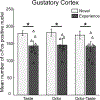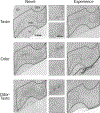Experience-dependent c-Fos expression in the primary chemosensory cortices of the rat
- PMID: 30244018
- PMCID: PMC6289795
- DOI: 10.1016/j.brainres.2018.09.019
Experience-dependent c-Fos expression in the primary chemosensory cortices of the rat
Abstract
Eating a new food is a unique event that guides future food choices. A key element for these choices is the perception of flavor (odor-taste associations), a multisensory process dependent upon taste and smell. The two primary cortical areas for taste and smell, gustatory cortex and piriform cortex, are thought to be crucial regions for processing and responding to odor-taste mixtures. To determine how previous experience impacts the primary chemosensory cortices, we compared the expression of the immediate early gene, c-Fos, between rats presented with a taste, an odor, or an odor-taste mixture for the first-time with rats that had many days of prior experience. Compared to rats with prior experience, we found that first-time sampling of all three chemosensory stimuli led to significantly greater c-Fos expression in gustatory cortex. In piriform cortex, only the novel chemosensory stimuli containing odors showed greater c-Fos expression. These results indicate that prior experience with taste, odor, or odor-taste stimuli habituates responses in the primary chemosensory cortices and adds further evidence supporting gustatory cortex as a fundamental node for the integration of gustatory and olfactory signals.
Keywords: Gustatory cortex; Habituation; Odor-taste; Piriform cortex; Rat; c-Fos.
Copyright © 2018 Elsevier B.V. All rights reserved.
Figures






Similar articles
-
Multisensory Integration Underlies the Distinct Representation of Odor-Taste Mixtures in the Gustatory Cortex of Behaving Rats.J Neurosci. 2024 May 15;44(20):e0071242024. doi: 10.1523/JNEUROSCI.0071-24.2024. J Neurosci. 2024. PMID: 38548337 Free PMC article.
-
Single-neuron responses to intraoral delivery of odor solutions in primary olfactory and gustatory cortex.J Neurophysiol. 2017 Mar 1;117(3):1293-1304. doi: 10.1152/jn.00802.2016. Epub 2016 Dec 21. J Neurophysiol. 2017. PMID: 28003413 Free PMC article.
-
Experience-Dependent c-Fos Expression in the Mediodorsal Thalamus Varies With Chemosensory Modality.Chem Senses. 2019 Jan 1;44(1):41-49. doi: 10.1093/chemse/bjy070. Chem Senses. 2019. PMID: 30388214 Free PMC article.
-
Functional neuroimaging of umami taste: what makes umami pleasant?Am J Clin Nutr. 2009 Sep;90(3):804S-813S. doi: 10.3945/ajcn.2009.27462R. Epub 2009 Jul 1. Am J Clin Nutr. 2009. PMID: 19571217 Review.
-
The gustatory cortex and multisensory integration.Int J Obes (Lond). 2009 Jun;33 Suppl 2(Suppl 2):S34-43. doi: 10.1038/ijo.2009.70. Int J Obes (Lond). 2009. PMID: 19528978 Free PMC article. Review.
Cited by
-
Multisensory Integration Underlies the Distinct Representation of Odor-Taste Mixtures in the Gustatory Cortex of Behaving Rats.J Neurosci. 2024 May 15;44(20):e0071242024. doi: 10.1523/JNEUROSCI.0071-24.2024. J Neurosci. 2024. PMID: 38548337 Free PMC article.
-
Perihematomal changes in glucose metabolism and cell counts in the rat collagenase model for intracerebral hemorrhage.Sci Rep. 2025 Aug 11;15(1):29338. doi: 10.1038/s41598-025-14689-3. Sci Rep. 2025. PMID: 40790063 Free PMC article.
-
Experience Informs Consummatory Choices for Congruent and Incongruent Odor-Taste Mixtures in Rats.Chem Senses. 2020 May 29;45(5):371-382. doi: 10.1093/chemse/bjaa025. Chem Senses. 2020. PMID: 32239150 Free PMC article.
-
An intra-oral flavor detection task in freely moving mice.iScience. 2024 Jan 16;27(2):108924. doi: 10.1016/j.isci.2024.108924. eCollection 2024 Feb 16. iScience. 2024. PMID: 38327778 Free PMC article.
-
The impact of familiarity on cortical taste coding.Curr Biol. 2022 Nov 21;32(22):4914-4924.e4. doi: 10.1016/j.cub.2022.09.053. Epub 2022 Oct 18. Curr Biol. 2022. PMID: 36261035 Free PMC article.
References
-
- Bonacchi KB, Ackroff K, Sclafani A, 2008. Sucrose taste but not Polycose taste conditions flavor preferences in rats. Physiol. Behav https://doi.org/10.1016/j.physbeh.2008.06.006 - DOI - PMC - PubMed
-
- Carleton A, Accolla R, Simon SA, 2010. Coding in the mammalian gustatory system. Trends Neurosci 33, 326–334. https://doi.org/10.1016/j.tins.2010.04.002 - DOI - PMC - PubMed
-
- Cerf-Ducastel B, Murphy C, 2001. fMRI activation in response to odorants orally delivered in aqueous solutions. Chem. Senses 26, 625–637. https://doi.org/10.1093/chemse/26.6.625 - DOI - PubMed
-
- Dalton P, Doolittle N, Nagata H, Breslin PAS, 2000. The merging of the senses: Integration of subthreshold taste and smell. Nat. Neurosci 3, 431–432. https://doi.org/10.1038/74797 - DOI - PubMed
-
- Datiche F, Cattarelli M, 1996. Reciprocal and topographic connections between the piriform and prefrontal cortices in the rat: A tracing study using the B subunit of the cholera toxin. Brain Res. Bull 41, 391–398. https://doi.org/10.1016/S0361-9230(96)00082-2 - DOI - PubMed
Publication types
MeSH terms
Substances
Grants and funding
LinkOut - more resources
Full Text Sources
Other Literature Sources
Medical

